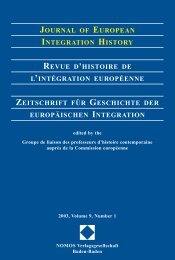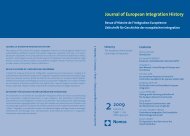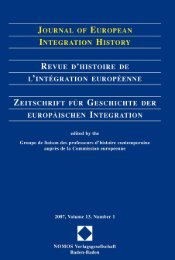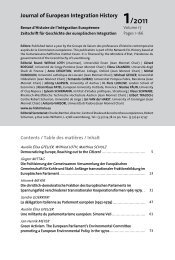journal of european integration history revue d'histoire de l ...
journal of european integration history revue d'histoire de l ...
journal of european integration history revue d'histoire de l ...
You also want an ePaper? Increase the reach of your titles
YUMPU automatically turns print PDFs into web optimized ePapers that Google loves.
From Isolation to the Core: Finland's Position towards European Integration 55<br />
scope <strong>of</strong> this tra<strong>de</strong> from foreign competition. Finland exported to the Soviet Union<br />
mainly manufactured goods and imported mainly raw materials, thus saving currencies.<br />
The economic <strong>de</strong>terminant <strong>of</strong> Finland's West European <strong>integration</strong> policies was,<br />
however, the necessity to safeguard economic relations with the leading West European<br />
countries with which the bulk <strong>of</strong> Finland's foreign tra<strong>de</strong> was conclu<strong>de</strong>d (see figure 1). 3<br />
Figure 1.<br />
Distribution <strong>of</strong> Finnish exports and imports by groups <strong>of</strong> countries, 1950-98<br />
Finland is usually characterised as belonging to the open economies <strong>of</strong> the small<br />
Nordic countries, with an export share varying, in different times, usually between<br />
about a fifth and a quarter <strong>of</strong> domestic production. Safeguarding the export interests<br />
has been the main point <strong>of</strong> <strong>de</strong>parture for the Finnish foreign economic policies.<br />
When the question <strong>of</strong> larger West European market formations became topical during<br />
the latter half <strong>of</strong> the 1950s, the principal Finnish anxiety was to avoid being left<br />
alone behind tariff walls. Up to the 1960s this concern referred almost exclusively<br />
to the export interests <strong>of</strong> wood-processing industries, but the argument suited also<br />
other export sectors.<br />
The en<strong>de</strong>avour to be i<strong>de</strong>ntified as a Western country has no doubt been an important<br />
driving force behind the country's pro-<strong>integration</strong> policies, even though it<br />
3. Statistical note to the figures:<br />
Imports by country <strong>of</strong> origin, exports by country <strong>of</strong> consumption/<strong>de</strong>stination. The original Standard International<br />
Tra<strong>de</strong> Classification (SITC) is used for tra<strong>de</strong> with individual countries and groups <strong>of</strong> countries<br />
for the years 1960-61. The SITC Rev. (1) is used for the years 1962-75, while also the figures for<br />
total tra<strong>de</strong> in 1954-61 are re-classified according to SITC Rev. (1). SITC Rev. 2 is used for the years<br />
1976-87 and SITC Rev. 3 from 1988 onwards. Sources: Suomen taloushistoria 3. Historiallinen tilasto<br />
– The Economic History <strong>of</strong> Finland 3. Historical Statistics, Helsinki 1983, Table 5.13; Finnish Official<br />
Statistics: Foreign Tra<strong>de</strong>, 1950-98 (The Customs Board <strong>of</strong> Finland), Helsinki, various years.

















